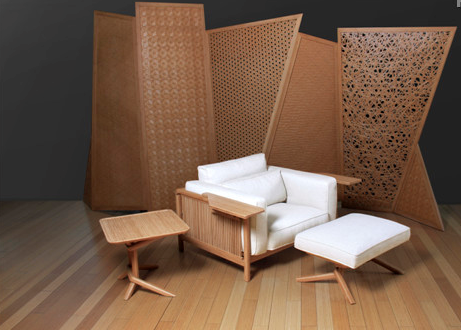
After spending years in the West with reputable jewelry houses, a designer returns to his roots in more ways than one.
Sitting in a studio filled with teapots and bamboo furniture, Dayu Shi hasn't stepped out of the building, where he works and lives, for four days while on his new project.
As he sips tea and plays with a geometric wood carving, the award-winning designer who has just won another award, the German Design Award 2016, is not in a hurry to explain his work, either.
"After all, your work speaks for itself," Shi, 51, says.
Once a top-notch jewelry designer, Shi has worked with some of the world's most expensive materials. But now he is into bamboo, one of the most common natural materials found in southern and eastern China.
"For me, the real challenge is to design with the most basic material," he says.
His Xiao Yao Chair, which the German Design Award jury says "brings comfort and function into optimum balance", is an example.
The chair combines cotton cushions with a bamboo frame, bringing together the elegance of the Chinese bamboo chair and the comfort of the Western sofa. Continuing his effort to push the boundaries on bamboo craftsmanship, Shi is exploring new techniques to enhance the structural strength of bamboo with this chair.
While he relied more on his sharp eyes as a jewelry designer, Shi says he has now found a new life with his fingers.
"When you understand the power of your hands, you realize that you shouldn't have depended only on your eyes. What you see with your eyes can be false, but what you feel with your hands can't fool you. You can feel the temperature, the texture and everything that you can't access on a computer screen."
Born to parents who moved to Taiwan, China from the Chinese mainland in 1949, Shi recalls that he reluctantly practiced traditional art as a child.
At 21, he eagerly left Taiwan, China to study at the Fashion Institute of Technology in New York and later worked as a designer for luxury jewelry company Harry Winston.
In 1996, he won the DeBeers Diamonds International Award, equivalent to the Oscars of the jewelry world.
"We tried our best to be like Americans," he says. "But when I was finally accepted by the industry, I started to look back and felt uncomfortable. I realized where I had come from. The education I had as a child, which I didn't understand early on, surfaced again. I got to notice it and became curious."
With the belief that design is meant to solve problems of people, he began to look at his roots with amazing results, like the idea of yielding and co-existing with nature using Chinese craftsmanship, which could be an answer to the destructive effects of the Industrial Revolution.
Shi returned to Taiwan, China in 1996 and opened Dragonfly Gallery, a pioneer design concept store where he displays the latest in design from around the world. The store not only became an inspiration for local designers but also an educational hub for local students of design.
In 2010, dismayed by the declining economy and political situation in Taiwan, China, Shi accepted an invitation to visit Beijing to set up his own design studio, as the city tried to develop its cultural sector by attracting designers and artists with favorable policies.
Shi's work ranges from jewelry to furniture, animation and digital products.
He won the iF Communication Design Award in 2007 and 2008 for his animation work. He was honored with the Red Dot Design Award four years in a row from 2009 to 2012 for designs including the Twins Round/Square Teapot Set and the bamboo chairs Jun-Zi and Qin-Jian.
Shi exhibited his Bamboo Project in Beijing in 2011, showcasing the potential of bamboo as a material for both building and interior design.
For Shi, bamboo is not just a substitute for wood. With its long fiber, bamboo can be strong, durable and elastic at the same time. It takes only 10 years to mature and produces 35 percent more oxygen than other types of trees, experts say.
It is often used in ancient Chinese literature and art to portray its zen-like quality.
While pushing the limits of bamboo craftsmanship, he is also trying to encourage bamboo farmers and manufacturers in China as a whole.
Shi says that it is time for him to focus on what he is really passionate about.
"My goal as a designer is to have influential works, rather than just profit ... There are prodigies in music, mathematics and physics but not in design. You have to have life experience, common sense and good powers of observation to be a good designer. At this age, I have to cherish the time I am left with."
He is now working on a new version of the "tea chair", a type of chair people use in tea houses in Chongqing, his father's birthplace.
He is also working with musician Feng Mantian to develop a new version of the ruan, a traditional Chinese plucked string instrument.
*This article was published on chinadaily.com.cn



























 沪公网安备31010402003309号
沪公网安备31010402003309号